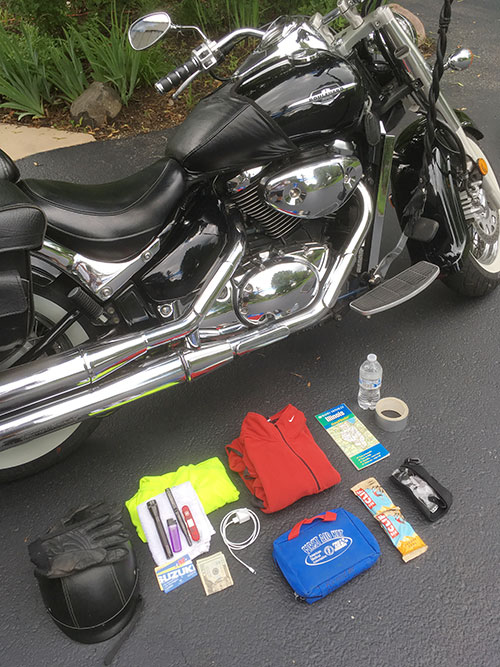American Motorcyclist August 2018
What’s In Your Saddlebag?
18 Tips For Packing Life-Saving Items

This year has already presented many examples of severe weather and emergencies that demonstrate the importance of having access to emergency supplies and equipment.
Floods, wildfires, tornadoes, intense storms and even lava flows are affecting the trails, streets and highways we ride.
Motorcyclists have a unique perspective on the roads. Of necessity, we are more aware, more tuned in. We can weave our way in and out of situations more quickly than cars and buses. We can more quickly evade danger or help those in need.
As a longtime motorcyclist, pilot and firearms instructor, I’m well-versed in training, safety, practice and preparedness. I don’t mind putting in the needed time and even enjoy the process.
With preparation in mind, during the past few months, I’ve started to change what I carry on my bike when I ride—be it a 100-mile loop or a five-minute errand to the grocery store.
To help you be better equipped and helpful to others—and perhaps yourself—here’s a list of some everyday carry items and how they can help.
 1. Flashlight: A reliable, bright/blinking/strobe flashlight or headlamp has more uses than merely seeing in the dark. It can be defensive weapon, a traffic signal or a distress call.
1. Flashlight: A reliable, bright/blinking/strobe flashlight or headlamp has more uses than merely seeing in the dark. It can be defensive weapon, a traffic signal or a distress call.
2. High quality knife: A folding knife with a 3- to 4-inch sharp locking blade is needed for such things as removing clothing to access an injury, cutting seatbelts, breaking glass with the butt end or opening supplies.
3. First-aid kit: Even a simple kit is useful. Consider adding a tourniquet and an Israeli bandage for a serious chest wound, arterial bleeding or severed limb. If you happen on a serious injury, you’ll need more than a bandage and burn cream.
4. Cellphone and charger: There’s not always a wall outlet on the road, but there are millions of cars around you. Having both is a good idea—for you and for other victims, for EMS and witnesses, as well.
5. First aid manual: Despite what you know, others may need to review or read instructions to perform a procedure.
6. Simple food: A few energy bars, nuts, candy, gum and a bottle of water may be useful to defuse hunger or a tense situation. These also can aid a person in diabetic distress, dehydration or shock.
7. Half a tank of fuel: Keep your tank at least half full whenever possible. You or someone may need to go for help, run power, run your lights/flashers, etc. The fuel can be used to start a fire, or someone may need the gas to get their car going to transport an injured person. (A siphon, used correctly, may also be useful.)
8. A physical map of the area: Phones are great, but what if the person needs to leave and can’t find their way? A map helps.
9. A compass: In this digital-directions age, some people don’t know N-S-E-W.
10. A tactical pen: A good tactical pen gives you a writing tool, as well as a tool for opening items, repairing things and so on.
11. Extra clothing: A light jacket or sweater can be a lifesaver.
12. Handheld lighter: Signaling, lighting a fire, a torch, a candle, can be critical for survival and rescue.
13. Extra pair of riding glasses for an emergency passenger.
14. A strong cord: A 10-foot cord can secure a broken arm, tie off a branch, etc.
15. Cash: Keep $100 tucked into your tool bag for emergencies.
16. AMA Roadside Assistance: If you don’t have it, get it, and keep the number handy so you can call immediately for help.
17. Medical ID: Keep your medical information accessible, listing blood type, allergies and important medical conditions.
18. Duct tape: A small or half roll will help someone secure a loose load a car-top carrier, close a wound or seal a loose window.
Russ Riendeau is an AMA member.
What are your favorite emergency supplies? Let us know at [email protected].
